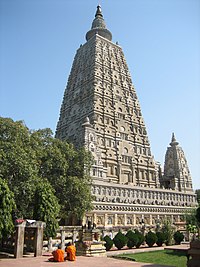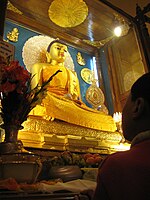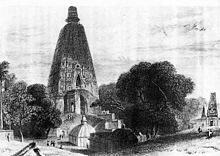Mahabodhi Temple: Difference between revisions
| Line 97: | Line 97: | ||
*[http://www.buddhistplacesinindia.com/bodhgaya-temple-in-bihar.aspx Mahabodhi Temple in Bihar] |
*[http://www.buddhistplacesinindia.com/bodhgaya-temple-in-bihar.aspx Mahabodhi Temple in Bihar] |
||
*[http://koenraadelst.voiceofdharma.com/books/acat/ch3.htm The Bodh Gaya temple controversy] |
*[http://koenraadelst.voiceofdharma.com/books/acat/ch3.htm The Bodh Gaya temple controversy] |
||
*[www.gounesco.com/train-travel-itinerary-world-heritage-sites-india/ Train travel to |
* [http://www.gounesco.com/train-travel-itinerary-world-heritage-sites-india/ Train travel to UNESCO world heritage sites in India] |
||
{{World Heritage Sites in India}} |
{{World Heritage Sites in India}} |
||
Revision as of 03:45, 7 January 2014
| UNESCO World Heritage Site | |
|---|---|
 | |
| Criteria | Cultural: (i)(ii)(iii)(iv)(vi) |
| Reference | 1056 |
| Inscription | 2002 (26th Session) |
| Coordinates | 24°41′46″N 84°59′29″E / 24.696004°N 84.991358°E |
The Mahabodhi Temple (महाबोधि मंदिर) (Literally: "Great Awakening Temple"), a UNESCO World Heritage Site, is a Buddhist temple in Bodh Gaya, marking the location where Siddhartha Gautama, the Buddha, is said to have attained enlightenment. Bodh Gaya (located in Gaya district) is located about 96 km (60 mi) from Patna, Bihar state, India.
Next to the temple, on its western side, is the holy Bodhi tree. In the Pali Canon, the site is called Bodhimanda,[1] and the monastery there the Bodhimanda Vihara. The tallest tower is 55 metres (180 ft) tall. The Vault of Mahabodhi Temple is being coated with Gold plates weighing 290 kg by the Government of Thailand.[2]
The Buddha

Traditional accounts say that, around 530 BC, Siddhartha Gautama, a young prince who saw the suffering of the world and wanted to end it, reached the forested banks of Falgu River, near the city of Gaya, India. There he sat in meditation under a peepul tree (Ficus religiosa or Sacred Fig),[3] which later became known as the Bodhi tree. According to Buddhist scriptures, after three days and three nights, Siddharta attained enlightenment and the answers that he had sought. In that location, Mahabodhi Temple was built by Emperor Ashoka in around 260 BC.[4]
The Buddha then spent the succeeding seven weeks at seven different spots in the vicinity meditating and considering his experience. Several specific places at the current Mahabodhi Temple relate to the traditions surrounding these seven weeks:[4]
- The first week was spent under the Bodhi tree.
- During the second week, the Buddha remained standing and stared, uninterrupted, at the Bodhi tree. This spot is marked by the Animeshlocha Stupa, that is, the unblinking stupa or shrine, which is located on the north-east of the Mahabodhi Temple complex. There stands a statue of Buddha with his eyes fixed towards the Bodhi tree.
- The Buddha is said to have walked back and forth between the location of the Animeshlocha Stupa and the Bodhi tree. According to legend, lotus flowers sprung up along this route, it is now called Ratnachakarma or the jewel walk.
- He spent the fourth week near Ratnagar Chaitya, located near north - east side.
- During the fifth week, Buddha answered in details to the queries of Brahmins under Ajapala Nigodh tree, now marked by a pillar.
- He spent the sixth week next to Lotus pond.
- He spent the seventh week under Rajyatna tree.[4]
Traditional Holy Site

The Bodhi tree at Bodhgaya is directly connected to the life of the historical Buddha, Siddhartha Gautama (566—486 BCE), who attained enlightenment or perfect insight when he was meditating under an ancestor of this Pipal tree.[4] The temple was built directly to the east of the Bodhi tree under which the Buddha spent his first week after attaining enlightenment (or its direct descendant in a line that continues to this day).[4]
According to Buddhist mythology, if no Bodhi tree grows at the site, the ground around the Bodhi tree is devoid of all plants for a distance of one royal karīsa and nothing can travel in the air immediately above it, not even Sakka[clarification needed].[5]
According to the Jatakas, the navel of the earth lies at this spot,[6] and no other place can support the weight of the Buddha's attainment.[7] Another Buddhist tradition claims that when the world is destroyed at the end of a kalpa, the Bodhimanda is the last spot to disappear, and will be the first to appear when the world emerges into existence again. Tradition also claims that a lotus will bloom there, and if a Buddha is born during that the new kalpa, the lotus flowers in accordance with the number of Buddhas expected to arise.[8] According to legend, in the case of Gautama Buddha, a Bodhi tree sprang up on the day he was born.[9]
Temple Construction

In approximately 250 BCE, about 200 years after the Buddha attained Enlightenment, Buddhist Emperor Asoka visited Bodh Gaya in order to establish a monastery and shrine on the holy site.[4] The new Mahabodhi temple included a diamond throne (called the Vajrasana) to mark the exact spot of the Buddha's enlightenment. While Asoka is considered the Mahabodhi temple's founder, the current structure dates from the 5th–6th century.[4] One scholar, however, considers the building "largely a nineteenth-century British Archaeological Survey of India reconstruction based on what is generally believed to be an approximately fifth-century structure." Prior to that, there seems to have been a pyramidal structure perhaps built in about the second century (Kuṣāṇa period). Knowledge of it comes only from a small, circa fourth century terracotta plaque found at modern Patna. It is significant that this version does not have the upper terrace with the small temples in the four corners. These small temples, although not used as such today, probably reflected certain esoteric traditions in Buddhism that were emerging more and more into less esoteric contexts by the late fourth and early fifth century. The pyramidal temple probably replaced an open pavilion that had been constructed around the tree and the Asokan platform. Representations of this early temple arc found at Sanci, on the toraṇas of Stūpa I, dating from around 25 BC, and on a relief carving from the stupa railing at Bhāhrut (Fig.20), from the early Śuṇga period (c. 185-c. 73 BC).[10]
Mahabodhi is one of the earliest Buddhist temples built entirely in brick that is still standing in India, from the late Gupta period.
Decline

Buddhism declined when the dynasties patronizing it declined, following White Hun and the early Arab Islamic invasions such as that of Muhammad bin Qasim. A strong revival occurred under the Pala Empire in the northeast of the subcontinent (where the temple is situated). Mahayana Buddhism flourished under the Palas between the 8th and the 12th century. However, after the defeat of the Palas by the Hindu Sena dynasty, Buddhism's position again began to erode and became nearly extinct in India. During the 12th century CE, Bodh Gaya and the nearby regions were invaded by Muslim Turk armies. During this period, the Mahabodhi Temple fell into disrepair and was largely abandoned.[4] Over the following centuries, the monastery's abbot or mahant position became occupied by the area's primary landholder, who claimed ownership of the Mahabodhi Temple grounds.
In the 13th century, Burmese Buddhists built a temple with the same name and modeled on the original Mahabodhi Temple. See Mahabodhi Temple, Bagan.[11]
Restoration
During the 11th century and the 19th century, Burmese rulers undertook restoration of the temple complex and surrounding wall.[12] In the 1880s, the then-British government of India began to restore Mahabodhi Temple under the direction of Sir Alexander Cunningham. In 1885, Sir Edwin Arnold visited the site and under guidance from Ven. Weligama Sri Sumangala published several articles drawing the attention of the Buddhists to the deplorable conditions of Buddhagaya.[13][14][15] A short time later, in 1891, the Sri Lankan Buddhist leader Anagarika Dharmapala started a campaign to return control of the temple to Buddhists, over the objections of the Hindu mahant. The campaign was partially successful in 1949, when control passed from the Hindu mahant to the state government of Bihar, which established a temple management committee. The committee has nine members, a majority of whom, including the chairman, must by law be Hindus.[16] Mahabodhi's first head monk under the management committee was Anagarika Munindra, a Bengali man who had been an active member of the Maha Bodhi Society.
2013 attack
On 7 July 2013, ten low-intensity bombs exploded in the temple complex, injuring 5 people. One bomb was near the statue of Buddha and another was near the Mahabodhi tree. Three unexploded bombs were also found and defused. The blasts took place between 5.30 a.m. and 6.00 a.m.[17][18] The main temple is intact and sanitized.[17] The Intelligence Bureau of India may have alerted state officials of possible threats around 15 days prior to the bombing.[19] On 4 November 2013, the National Investigation Agency announced that the Islamist jihadi group Indian Mujahideen was responsible for the bombings.[20][21]
Architectural style
Mahabodhi Temple is constructed of brick and is one of the oldest brick structures to have survived in eastern India. It is considered to be a fine example of Indian brickwork, and was highly influential in the development of later architectural traditions. According UNESCO, "the present temple is one of the earliest and most imposing structures built entirely in brick from Gupta period".[4] Mahabodhi Temple's central tower rises 55 metres (180 ft), and were heavily renovated in the 19th century. The central tower is surrounded by four smaller towers, constructed in the same style.
The Mahabodhi Temple is surrounded on all four sides by stone railings, about two metres high. The railings reveal two distinct types, both in style as well as the materials used. The older ones, made of sandstone, date to about 150 BCE, and the others, constructed from unpolished coarse granite, are believed to be of the Gupta period (300–600 CE). The older railings have scenes such as Lakshmi, the Hindu goddess of wealth, being bathed by elephants; and Surya, the Hindu sun god, riding a chariot drawn by four horses. The newer railings have figures of stupas (reliquary shrines) and garudas (eagles). Images of lotus flowers also appear commonly.
Current status and management

The Bihar state government assumed responsibility for the protection, management, and monitoring of temple and its properties when India gained its independence. Pursuant to the Bodh Gaya Temple Act of 1949, such responsibilities are shared with the Bodhgaya Temple Management Committee, and an advisory board. By law, the Committee must consist of four Buddhist and four Hindu representatives, including the head of Sankaracharya Math monastery as an ex-officio Hindu member.[22] The Committee serves for a three year term.[22] A 2013 Amendment to Bodhgaya Temple Management Act allows the Gaya District Magistrate to be the Chairman of committee, even if he is not Hindu.[23] The Advisory Board consists of the governor of Bihar and twenty to twenty-five other members, half of them from foreign Buddhist countries.
In June 2002, the Mahabodhi Temple became a UNESCO World Heritage Site.[22] All finds of religious artifacts in the area are legally protected under the Treasure Trove Act of 1878.
The temple's head monk, Bhikkhu Bodhipala, resigned in 2007 after he was charged with cutting the branches of Holy Bodhi Tree on regular basis and selling them to foreigners for significant amounts of money. A newspaper alleged that wealthy Thai buyers bought a branch with the cooperation of senior members of the temple's management committee.[24] While the temple's spokesman stated that botanists had pruned the tree, the Bihar home secretary ordered the tree examined.[25] A criminal charge was filed against Bodhipala.[citation needed] If convicted, Bodhipala would be subject to at least 10 years' imprisonment.
Following the expiration of the Committee's term in September 2007, Bihar's government delayed appointing a new Committee and the district magistrate administered the temple pending such appointment.[22] Eventually, on May 16, 2008 the government announced the appointment of a new Temple Management Committee.[26]
See also
| Part of a series on |
| Buddhism |
|---|
 |
References
- ^ In Pali, using Romanized diacritic marks, the word is spelled bodhimaṇḍa. This term is found throughout the Buddhavamsa and, in one place, in the Jataka (Ja iv.238). Horner (2000) translates bodhimaṇḍa as "the dais of the Tree of Awakening" (e.g., pp. 15 v. 65, 25 v. 183, passim).
- ^ "Mahabodhi Temple at Bodhgaya to be Coated with 290 Kg Gold". Biharprabha News. Retrieved 12 November 2013.
- ^ Although some sources call the tree a Banyan, such is a different fig species.
- ^ a b c d e f g h i "Mahabodhi Temple Complex at Bodh Gaya". UNESCO. Retrieved 7 July 2013.
{{cite web}}:|first=missing|last=(help) - ^ J.iv.232f
- ^ J.iv.233 (puthuvinābhi)
- ^ J.iv.229
- ^ DA.ii.412
- ^ DA.ii.425; BuA.248
- ^ "Sowing the Seeds of the Lotus: A Journey to the Great Pilgrimage Sites of Buddhism, Part I" by John C. Huntington. Orientations, November 1985 pg 61
- ^ http://www.myanmars.net/myanmar-travel/myanmar-bagan/mahabodhi.htm
- ^ [1]
- ^ Maha Bodhi Society
- ^ India Revisited by Sri Edwin Arnold
- ^ Dipak K. Barua, “Buddha Gaya Temple: its history”
- ^ Buddha Gaya Through the Ages. Delhi: Sri Satguru Publications. 1994. pp. 127–133. ISBN 81-7030-409-1.
{{cite book}}:|first=missing|last=(help) - ^ a b "Serial Blasts rock Mahabodhi temple in Bodha gaya: terror attack, Center says". The Times of India. 7 July 2013. Retrieved 7 July 2013.
- ^ Law, Kumar Mishra (7 July 2013). "5 injured in multiple blasts at Mahabodhi temple in Bodh Gaya". The Times of India. Retrieved 7 July 2013.
- ^ http://articles.timesofindia.indiatimes.com/2013-06-26/patna/40205596_1_bodh-gaya-mahabodhi-mock-drills
- ^ Tiwari, Deeptiman (6 November 2013). "Ranchi document helps NIA crack Bodh Gaya blast case". Times of India. Retrieved 6 November 2013.
- ^ Gaikwad, Rahi; Yadav Anumeha; Pandey Devesh (7 November 2013). "Patna terror cell behind Bodh Gaya strike too: NIA". The Hindu. Patna, Ranchi, New Delhi. The Hindu. Retrieved 7 November 2013.
- ^ a b c d Buddhists seek control over Mahabodhi temple management IANS. March 28, 2008. Retrieved March 29, 2008.
- ^ "The Controversial Bodhgaya Temple (Amendment) Bill 2013". Retrieved 1 October 2013.
- ^ Scandal gnaws at Buddha's holy tree in India. Denyer, Simon. Reuters News Service. February 3, 2008. Retrieved March 27, 2008.
- ^ No damage to Bodhi tree: Govt. Singh, Sanjay. July 21, 2006. Retrieved March 27, 2008.
- ^ "Holiest Buddhist shrine gets governing panel, finally". Thaindian.com. 2008-05-17. Retrieved 2010-04-24.
Sources
- Horner, I.B. (trans.) (1975; reprinted 2000). The Minor Anthologies of the Pali Canon (Part III): 'Chronicle of Buddhas' (Buddhavamsa) and 'Basket of Conduct' (Cariyapitaka). Oxford: Pali Text Society. ISBN 0-86013-072-X.

